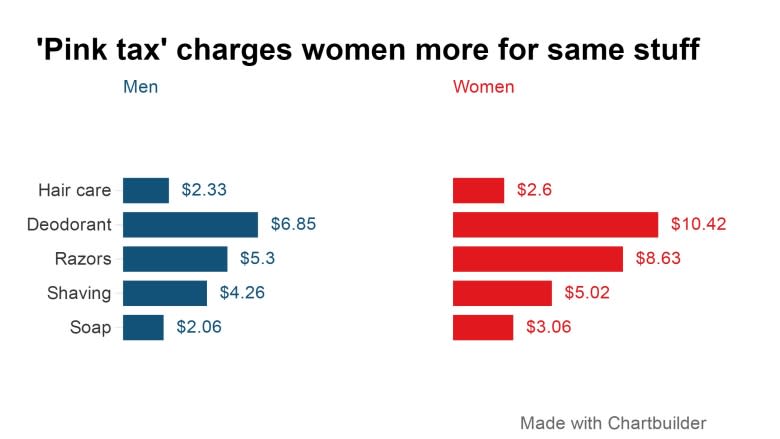'Pink tax' sees women pay 43% more than men for personal care products: report

Women in Canada pay a "pink tax" premium of more than 40 per cent over what men pay when it comes to personal care products, according to a recent study.
Data mining company ParseHub says women pay a six per cent premium on the average priced razor, shampoo, soap, deodorant and shaving cream for women and men. A woman would pay $47.57 and a man would pay $44.84.
However, ParseHub points out that the products for men and women are often sold in different quantities, complicating comparisons.
In a blog post published, Sheetal Persaud said the discrepancy between what women and men pay becomes more apparent when prices are broken down to a per-unit basis, such as the cost per 100 mL or 100 g.
ParseHub said it looked at over 3,199 personal care products from walmart.ca, well.ca and loblaws.ca.
After the products were grouped as for men, women, unisex and kids, Parsehub said they were than categorized into five groups: deodorant and antiperspirant; razors; shaving creams and lotions; soaps and bodywash; and hair care.
Adding up the price premiums that women paid for the average price per unit in each of those groups, Parsehub said women pay 43 per cent more than men.
Shop unisex
For women looking to avoid paying extra, Persaud suggests buying unisex products.
"Most unisex products are either budget items so you'll save money, or natural/organic products so you'll be paying for better ingredients, not a gender based mark-up," she wrote.
"Alternatively, just buy products for men," she said.
CBC's Marketplace looked the issue of gender price discrepancies in November 2014 and found some similar results.
The show sampled products at Walmart, Target (before it went out of business in Canada) and Hudson's Bay, and found some instances where women got much less product than men did, while in others they paid more than twice what men did for comparable products from the same manufacturer.
The three retailers said the price gaps reflected differences in packaging, manufacturing costs or ingredients and were not based on gender.
Some jurisdictions in the U.S. bar gender-based price discrimination. New York City has had a law banning gender pricing since 1998, although a December 2015 study by the city's Department of Consumer Affairs found numerous examples of it, suggesting the city may not be able to stop the practice.
A bill to block price discrimination on the basis of gender was introduced in Ontario in 2005, but it apparently never made it past the committee stage.

 Yahoo Finance
Yahoo Finance 